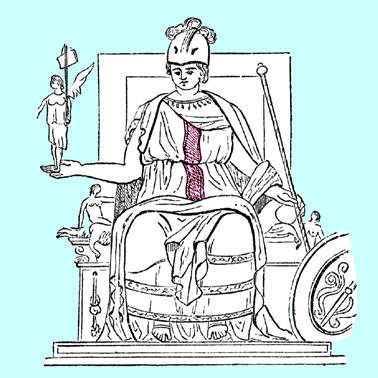|
|
| Line 1: |
Line 1: |
| | + | {{stub}} |
| | + | |
| | [[Image:Clavus latus2341.gif|thumb]] | | [[Image:Clavus latus2341.gif|thumb]] |
| − | CLAVUS LATUS, CLAVUS ANGUSTUS. The meaning of these words has given rise to much dispute; but it is now established beyond doubt that the clavus latus was a broad [[purple]] band, extending perpendicularly from the neck down the centre of the [[tunica]], and that the clavus angustus consisted of two narrow purple slips, running parallel to each other from the top to the bottom of the tunic, one from each shoulder. Hence we find the tunic called the tunica laticlavia and angusticlavia. These purple stripes were woven into the [[tunic]]; and this circumstance accounts for the fact that the clavus is never represented in works of sculpture. It only occurs in paintings, and those too of a very late period. The clavus latus is represented in the annexed cut, which is copied from a painting of Rome personified, formerly belonging to the Barberini family.
| + | In [[Classic garb]], the [[laticlave]] or '''clavus''' was a broad purple stripe on the front of the [[tunic]], worn by Roman senators as a symbol of office. |
| − | | |
| − | The latus clavus was a distinctive badge of the senatorian order and hence it is used to signify the senatorial dignity The angustus clavus was the decoration of the equestrian order; but the right of wearing the latus clavus was also given to the children of equestrians at least in the time of Augustus, as a prelude to entering the senate-house. This, however, was a matter of personal indulgence, and not of individual right; for it was granted only to persons of very ancient family, and corresponding wealth , and then by special favour of the emperor. In such cases the latus clavus was assumed with the toga virilis, and worn until the age arrived at which the young equestrian was admissible into the senate, when it was relinquished and the angustus clavus resumed, if a disinclination on his part, or any other circumstances, prevented him from entering the senate, as was the case with Ovid But it seems that the latus clavus could be again resumed if the same individual subsequently wished to become a senator, and hence a fickle character is designated as one who is always changing his clavus.
| |
| | | | |
| − | The latus clavus is said to have been introduced at Rome by Tullus Hostilius, and to have been adopted by him after his conquest of the Etruscans; nor does it appear to have been confined to any particular class during the earlier periods, but to have been worn by all ranks promiscuously. It was laid aside in public mourning. | + | ===History=== |
| | + | The laticlave was a distinctive badge of the senatorian order, and was used to signify senatorial dignity. The purple stripe was woven into the [[tunic]], which accounts for the fact that the clavus is never represented in works of sculpture. It only occurs in paintings, and only those of late period Rome. |
| | | | |
| | [[Category:Men's Garb]] [[Category:Women's Garb]] [[Category:Garb]] [[Category:Classical Garb]] | | [[Category:Men's Garb]] [[Category:Women's Garb]] [[Category:Garb]] [[Category:Classical Garb]] |
Revision as of 01:37, 31 March 2016
 This article is a stub. You can help AmtWiki by expanding it. This article is a stub. You can help AmtWiki by expanding it.
|
In Classic garb, the laticlave or clavus was a broad purple stripe on the front of the tunic, worn by Roman senators as a symbol of office.
History
The laticlave was a distinctive badge of the senatorian order, and was used to signify senatorial dignity. The purple stripe was woven into the tunic, which accounts for the fact that the clavus is never represented in works of sculpture. It only occurs in paintings, and only those of late period Rome.
